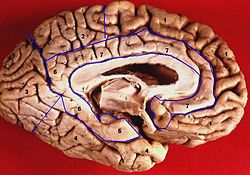| Limbic lobe | |
|---|---|
 Inferomedial view of the left cerebral hemisphere showing the limbic lobe in areas 5-7. | |
| Details | |
| Identifiers | |
| Latin | lobus limbicus gyrus fornicatus |
| MeSH | D065726 |
| NeuroNames | 834 |
| NeuroLex ID | birnlex_1128 |
| TA98 | A14.1.09.230 |
| TA2 | 5507 |
| FMA | 72719 |
| Anatomical terms of neuroanatomy | |
The limbic lobe is an arc-shaped cortical region of the limbic system, on the medial surface of each cerebral hemisphere of the mammalian brain, consisting of parts of the frontal, parietal and temporal lobes. The term is ambiguous, with some authors[who?] including the paraterminal gyrus, the subcallosal area, the cingulate gyrus, the parahippocampal gyrus, the dentate gyrus, the hippocampus and the subiculum;[1] while the Terminologia Anatomica includes the cingulate sulcus, the cingulate gyrus, the isthmus of cingulate gyrus, the fasciolar gyrus, the parahippocampal gyrus, the parahippocampal sulcus, the dentate gyrus, the fimbrodentate sulcus, the fimbria of hippocampus, the collateral sulcus, and the rhinal sulcus, and omits the hippocampus.






